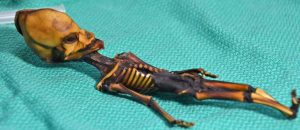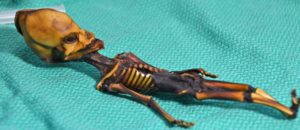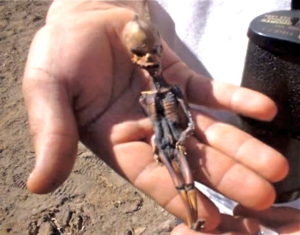
The Real Story Behind ‘Tiny Mummy’ In The Atacama Suspected To Be ‘Alien’
Someone nearly two decades ago discovered a tiny mummy in the Atacama Desert of northern Chile setting rumors that it was in fact a mummy of an alien.

When an amateur collector who was exploring a ghost town, he was reported to have seen a white cloth inside a leather pouch. When he unwrapped it, he found a six-inch-long skeleton.
The skeleton was remarkably complete. It even had hardened teeth in the jaw. Besides that there were striking anomalies: among which it had a total ten ribs of the usual 12, it also had giant eye sockets and also long skull that at last ended in a point.

Ata, was the name of the mummy as it came to be known, ended up in a private collection, but the rumors still continued, fueled in part by a U.F.O. documentary in 2013 that featured the skeleton. On Thursday, a team of scientists gave somewhat different explanation for Ata — one without it being an alien, but intriguing in its own way.
Ata’s bones contained DNA which not only proves that she was human, but also the fact that she belonged to the same local population. Then what’s more, the researchers identified in her DNA a group of mutations in genes which were related to bone development. Some of these mutations might be the reason responsible for the skeleton’s bizarre form, causing a hereditary disorder never before documented in humans till now.
Antonio Salas Ellacuriaga, a geneticist at the University of Santiago de Compostela in Spain who was not involved in the new study, called it “a very beautiful example of how genomics can help to disentangle an anthropological and archaeological dilemma.”
“DNA autopsies,” as Dr. Ellacuriaga calls them, could help shed light on medical disorders “by looking to the past to understand the present.”
The research, which was published in the journal Genome Research, was started in 2012, when Garry P. Nolan, an immunologist at Stanford University, got wind of the U.F.O. documentary, “Sirius,” while it was still in production process.
Dr. Nolan emailed the documentary producers and offered to have a look for DNA in the mummy. The skeleton’s owner agreed to X-ray images as well as bone marrow samples to be taken from the ribs and right humerus of the mummy.
Once Dr. Nolan and his colleagues received the samples, they were able to retrieve fragments of DNA from bone marrow cells without having to do much struggle. “We could tell this was human right away,” said Atul Butte, a computational biologist at the University of California, San Francisco, and a co-author of the new study.
The scientists at last managed to reconstruct much of Ata’s genome structure. She was in fact a girl, they found, who was most closely related to indigenous Chileans. But she also had a substantial amount of ancestry of Europeans.
You May Also Read: As A Pod Of 150 Whales Wash Ashore In Western Australia, Rescuers Try There Luck To Find Any Survivors